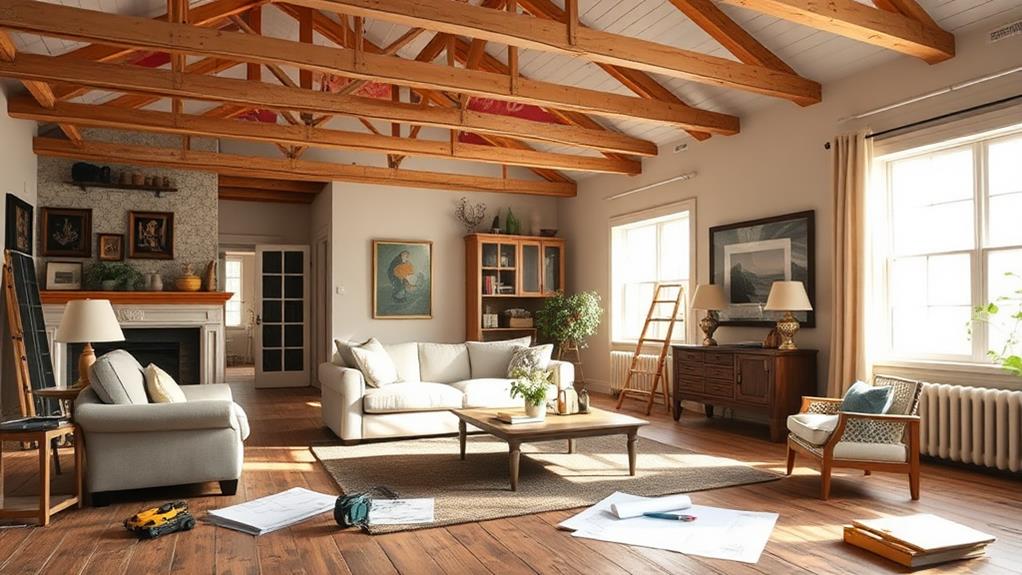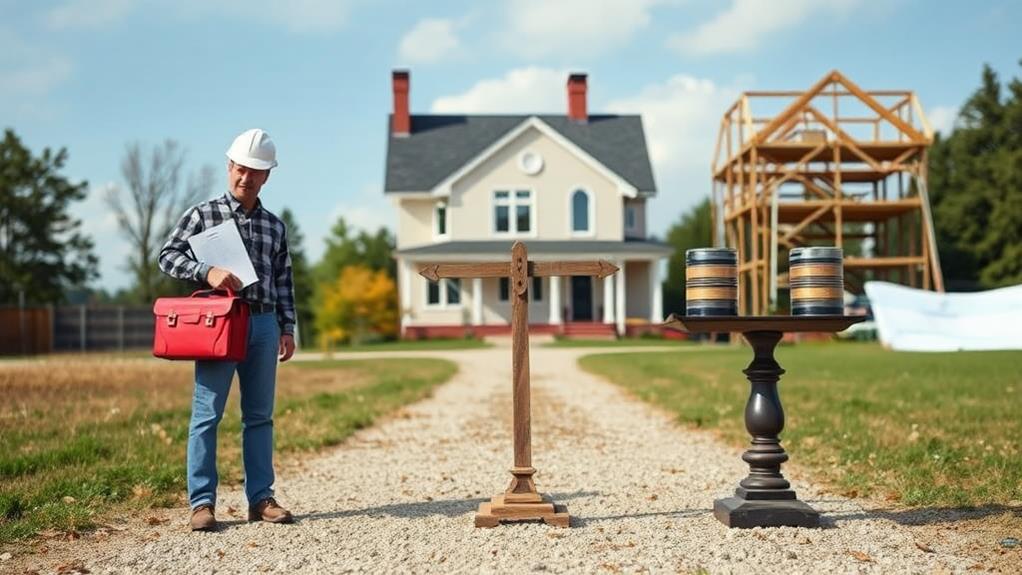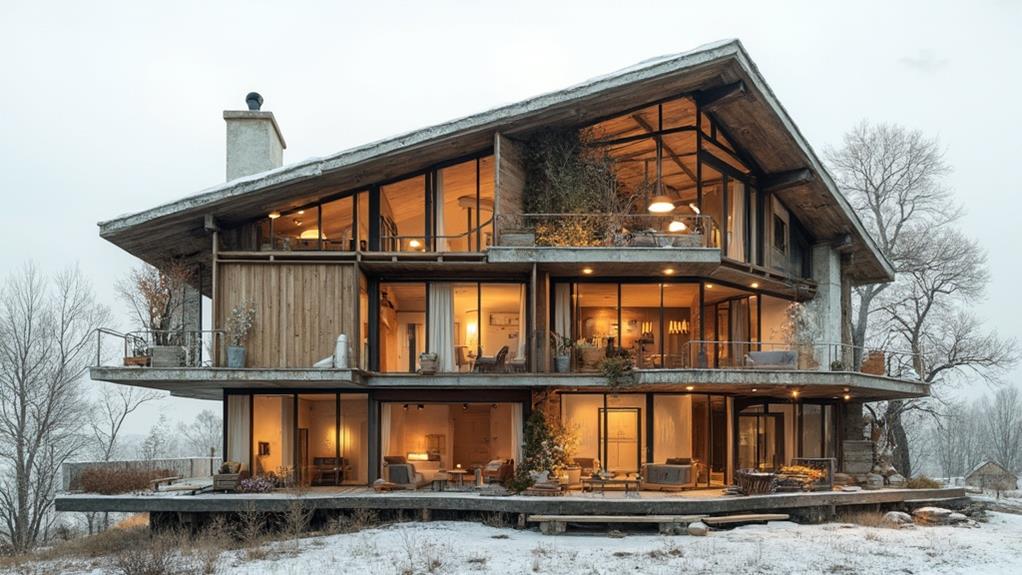Balancing structural improvements with cosmetic updates in your renovation budget requires careful prioritization. Start by addressing critical safety and functionality issues like electrical, plumbing, and foundation problems. Allocate remaining funds to high-impact cosmetic upgrades that enhance both enjoyment and home value. Create a detailed budget spreadsheet, listing planned improvements and estimated costs. Consider phasing your project to maintain control and minimize disruption. Opt for cost-effective aesthetic improvements like painting, updated hardware, and refinishing existing features. Weigh long-term value against immediate gratification when making decisions. By following a strategic approach, you'll maximize your renovation's impact while ensuring a solid foundation for your home's future.
Assessing Your Home's Structural Needs

Many homeowners overlook the critical importance of assessing their home's structural needs before embarking on renovation projects. This oversight can lead to costly repairs and safety hazards down the line.
To properly evaluate your home's structural integrity, start by inspecting the foundation for cracks, shifts, or water damage. Look for signs of settling, such as uneven floors or doors that don't close properly. Examine the roof for missing shingles, sagging areas, or water stains on ceilings, which could indicate potential leaks.
Check the electrical system for outdated wiring, insufficient capacity, or faulty circuit breakers. Assess the plumbing for leaks, corrosion, or low water pressure. Evaluate the HVAC system's efficiency and age, as older units may require replacement. Don't forget to inspect windows and doors for drafts or rot, which can impact energy efficiency and security.
If you're unsure about any aspect of your home's structure, consider hiring a professional home inspector. They can provide a comprehensive assessment and identify potential issues that may not be immediately apparent. Prioritizing structural improvements ensures a solid foundation for any cosmetic updates you plan to make, ultimately protecting your investment and enhancing your home's longevity.
Identifying High-Impact Cosmetic Upgrades
Once structural concerns have been addressed, homeowners can turn their attention to high-impact cosmetic upgrades that significantly enhance a property's aesthetic appeal and value. These upgrades should focus on areas that potential buyers or appraisers immediately notice, such as the kitchen, bathrooms, and curb appeal.
In the kitchen, consider updating countertops, replacing outdated appliances, or refacing cabinets. These changes can dramatically modernize the space without requiring a full renovation.
For bathrooms, new fixtures, updated lighting, and fresh tile can create a spa-like atmosphere that appeals to many homeowners.
Enhancing curb appeal is crucial for making a strong first impression. This may involve repainting the exterior, updating landscaping, or installing a new front door. Inside, a fresh coat of paint in neutral tones can refresh the entire home at a relatively low cost.
Other high-impact upgrades include replacing worn carpeting with hardwood or luxury vinyl plank flooring, updating light fixtures throughout the house, and installing smart home technology. These improvements not only boost visual appeal but also contribute to the overall functionality and efficiency of the home, making them valuable investments for both current and future occupants.
Creating a Balanced Renovation Budget

After identifying essential structural improvements and desirable cosmetic upgrades, homeowners must create a balanced renovation budget that allocates resources effectively. Begin by prioritizing structural improvements, as these are critical for the home's safety and longevity. Allocate a significant portion of the budget to address issues like foundation repairs, roof replacement, or electrical system upgrades.
Next, assess the remaining funds for cosmetic updates. Focus on high-impact changes that offer the best return on investment, such as kitchen and bathroom renovations or flooring upgrades. Consider cost-effective alternatives that can achieve similar aesthetic results without breaking the bank.
Create a detailed spreadsheet listing all planned improvements, their estimated costs, and potential contingencies. Include a buffer of 10-20% for unexpected expenses. Research financing options, such as home equity loans or renovation-specific loans, to supplement your budget if necessary.
Regularly review and adjust your budget throughout the renovation process. Be prepared to make trade-offs between structural and cosmetic improvements as unforeseen issues arise. By maintaining a flexible yet balanced approach, homeowners can ensure both the structural integrity and visual appeal of their property within their financial means.
Prioritizing Safety and Functionality
When balancing structural improvements with cosmetic updates, it's crucial to prioritize safety and functionality above all else. This approach ensures that your home remains a secure and comfortable living space while also maintaining its value.
Start by addressing critical issues such as electrical wiring, plumbing, foundation problems, and roof repairs. These elements form the backbone of your home's integrity and should take precedence over aesthetic upgrades.
Next, focus on functionality improvements that enhance your daily life. This may include updating HVAC systems, installing energy-efficient windows, or improving insulation. These changes not only increase comfort but also contribute to long-term cost savings through reduced energy consumption. Consider accessibility modifications if needed, such as widening doorways or installing grab bars, to ensure your home remains suitable for all occupants.
Only after addressing safety and functionality should you allocate resources to cosmetic updates. Prioritize areas that impact your home's overall appeal and value, such as kitchens and bathrooms. By maintaining this hierarchy of improvements, you create a solid foundation for future renovations while ensuring your home remains safe, functional, and comfortable for years to come.
Cost-Effective Aesthetic Improvements

Cost-effective aesthetic improvements can significantly enhance your home's visual appeal without breaking the bank. Focus on high-impact, low-cost updates that refresh your living spaces. Painting is one of the most affordable ways to transform a room, with a new color scheme instantly modernizing the area. Consider accent walls or textured finishes for added interest.
Updating hardware on cabinets, doors, and drawers is another budget-friendly option that can give your home a more cohesive look. Replace outdated light fixtures with contemporary designs to improve both aesthetics and energy efficiency. For flooring, consider refinishing existing hardwood or installing luxury vinyl planks as a cost-effective alternative to full replacement.
In the bathroom and kitchen, re-grouting tiles and replacing outdated faucets can make a significant difference. Add visual interest with affordable decor elements like throw pillows, area rugs, and wall art. Enhance curb appeal by focusing on landscaping improvements, such as adding potted plants, mulching garden beds, or painting the front door. These simple changes can create a fresh, updated look without compromising your budget for essential structural improvements.
Long-Term Value vs. Immediate Gratification
Balancing long-term value against immediate gratification is a crucial consideration when allocating your home improvement budget. Structural improvements often provide substantial long-term value, increasing your home's durability, energy efficiency, and overall worth. These investments, such as upgrading insulation, replacing an aging roof, or modernizing electrical systems, may not offer instant visual appeal but can significantly reduce maintenance costs and enhance your property's resale value.
Conversely, cosmetic updates deliver immediate satisfaction, transforming living spaces and boosting your home's aesthetic appeal. While these improvements can increase your enjoyment of the space and potentially attract buyers, they may not always yield the same long-term financial benefits as structural upgrades.
To strike an effective balance, prioritize essential structural improvements that address safety concerns or prevent costly future repairs. Then, allocate remaining funds to cosmetic updates that align with your personal preferences and current design trends. Consider projects that offer both functional and aesthetic benefits, such as energy-efficient windows or modern kitchen appliances. By thoughtfully weighing long-term value against immediate gratification, you can create a home improvement plan that maximizes both your enjoyment and your investment.
Phasing Your Renovation Project

Homeowners often underestimate the complexity of large-scale renovations, leading to budget overruns and project delays. Phasing your renovation project can help mitigate these issues by breaking the work into manageable stages, allowing for better financial planning and less disruption to daily life.
Begin by prioritizing essential structural improvements, such as foundation repairs, roof replacements, or electrical upgrades. These elements form the backbone of your home and should be addressed before cosmetic updates.
Next, focus on major systems like plumbing, HVAC, and insulation. Once the core infrastructure is sound, move on to room-specific renovations, starting with high-traffic areas like kitchens and bathrooms.
Phasing also allows for financial flexibility. By spreading costs over time, homeowners can save between phases or adjust their budget as needed. This approach also provides opportunities to reassess priorities and make informed decisions about subsequent stages based on completed work.
When planning phases, consider the logical sequence of work to avoid damaging finished areas. For example, complete any work requiring wall access before installing new flooring or applying fresh paint. By carefully phasing your renovation project, you can achieve a balance between structural improvements and cosmetic updates while maintaining budget control and minimizing stress.
Maximizing ROI on Home Improvements
While phasing a renovation project helps manage costs and disruptions, it's equally important to consider the long-term value of each improvement. Maximizing return on investment (ROI) requires a strategic approach to home improvements, balancing structural necessities with cosmetic enhancements that appeal to potential buyers.
Focus on updates that consistently yield high returns, such as kitchen and bathroom remodels, which typically recoup 70-80% of their cost. Energy-efficient upgrades, including modern HVAC systems and improved insulation, not only reduce utility bills but also attract eco-conscious buyers. Curb appeal improvements, like landscaping and exterior painting, offer excellent ROI by creating a strong first impression.
Avoid over-customization or luxury additions that may not align with neighborhood standards, as these can limit your home's marketability. Instead, opt for neutral, timeless design choices that appeal to a broad range of tastes. Prioritize addressing structural issues and outdated systems, as these can significantly impact your home's value and may become deal-breakers during a sale. By carefully selecting improvements that enhance both functionality and aesthetics, you can maximize your renovation budget's long-term impact on your home's value.
Hiring Professionals vs. DIY Approach

The decision between hiring professionals and taking a do-it-yourself approach can significantly impact the success of your home renovation project. When considering structural improvements, it's generally advisable to hire licensed professionals. These experts possess the necessary skills, knowledge, and tools to ensure that critical elements like foundations, load-bearing walls, and electrical systems are handled safely and up to code.
For cosmetic updates, the DIY approach can be more feasible and cost-effective. Tasks such as painting, installing new fixtures, or updating hardware are often within the capabilities of homeowners with basic skills and tools. However, it's crucial to honestly assess your abilities and available time before embarking on a DIY project.
Ultimately, the best approach may involve a combination of professional work and DIY efforts. Consider hiring professionals for complex, high-risk, or time-consuming tasks, while tackling simpler projects yourself. This strategy can help balance your budget while ensuring quality results. Remember to factor in the potential costs of mistakes or rework when deciding between professional and DIY approaches, as these can significantly impact your overall project expenses and timeline.
Frequently Asked Questions
How Do Local Building Codes Affect My Renovation Plans?
Local building codes significantly impact renovation plans by dictating safety standards, structural requirements, and permitting processes. These regulations ensure compliance with local laws, affecting aspects like electrical work, plumbing, and structural modifications. Consult your local building department for specific guidelines.
What Financing Options Are Available for Home Improvements?
Financing options for home improvements include home equity loans, personal loans, credit cards, cash-out refinancing, and government-backed renovation loans. Each option has unique terms, interest rates, and qualification requirements. Consult a financial advisor for personalized recommendations based on your situation.
How Can I Minimize Disruption to Daily Life During Renovations?
Like a well-orchestrated symphony, minimizing disruption during renovations requires careful planning. Create a detailed timeline, establish temporary living spaces, communicate with contractors, and consider phased renovations. Prepare meals in advance and maintain a flexible mindset throughout the process.
Are There Eco-Friendly Alternatives for Both Structural and Cosmetic Upgrades?
Numerous eco-friendly alternatives exist for both structural and cosmetic upgrades. Consider sustainable materials like bamboo flooring, recycled countertops, low-VOC paints, and energy-efficient appliances. For structural improvements, explore reclaimed wood, recycled steel, and eco-friendly insulation options.
How Do I Handle Unexpected Issues That Arise During the Renovation Process?
To handle unexpected issues during renovation, maintain a contingency fund, communicate promptly with contractors, prioritize urgent problems, and be flexible with your timeline. Document changes, seek expert advice when necessary, and adjust your budget accordingly to accommodate unforeseen challenges.
Conclusion
In the delicate dance of home renovation, striking a balance between structural integrity and aesthetic appeal is paramount. By carefully assessing needs, prioritizing safety, and strategically allocating resources, homeowners can achieve a harmonious blend of form and function. Like a well-composed symphony, a thoughtfully executed renovation plan orchestrates structural improvements and cosmetic updates into a cohesive whole, maximizing both immediate enjoyment and long-term value. Ultimately, this balanced approach ensures a home that is not only beautiful but also built to last.

